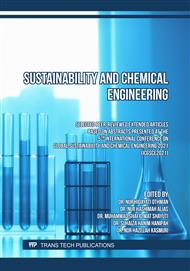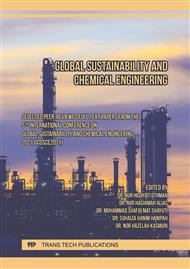[1]
Abbaszadeh, S., Wan Alwi, S. R., Webb, C., Ghasemi, N., & Muhamad, I. I., Treatment of lead-contaminated water using activated carbon adsorbent from locally available papaya peel biowaste. Journal of Cleaner Production, 118 (2016) 210-222.
DOI: 10.1016/j.jclepro.2016.01.054
Google Scholar
[2]
Abhari, P. S., Manteghi, F., & Tehrani, Z., Adsorption of lead ions by a green AC/HKUST-1 nanocomposite, Nanomaterials, 10(9) (2020).
DOI: 10.3390/nano10091647
Google Scholar
[3]
Ahn, C. K., Kim, Y. M., Woo, S. H., & Park, J. M., Removal of cadmium using acid-treated activated carbon in the presence of nonionic and/or anionic surfactants. Hydrometallurgy, 99(3–4) (2009) 209-213.
DOI: 10.1016/j.hydromet.2009.08.008
Google Scholar
[4]
Anbia, M., & Amirmahmoodi, S., Removal of Hg (II) and Mn (II) from aqueous solution using nanoporous carbon impregnated with surfactants. Arabian Journal of Chemistry, 9 (2016) 319-325.
DOI: 10.1016/j.arabjc.2011.04.004
Google Scholar
[5]
Burlatsky, S. F., Atrazhev, V. V., Dmitriev, D. V., Sultanov, V. I., Thimokina, E. N., Ugolkove, E. A., Tulyani, S. & Vincitore, A., Surface tension model for surfactant solutions at the critical micelle concentration, Journal of Colloid and Interface Science 393 (2013) 151 – 160.
DOI: 10.1016/j.jcis.2012.10.020
Google Scholar
[6]
Chen, W. fang, Zhang, Z. Y., Li, Q., & Wang, H. Y., Adsorption of bromate and competition from oxyanions on cationic surfactant-modified granular activated carbon (GAC). Chemical Engineering Journal, 203 (2012)319 – 325.
DOI: 10.1016/j.cej.2012.07.047
Google Scholar
[7]
Isam, M., Baloo, L., Sapari, N., Nordin, I., Yavari, S., & Al-Madhoun, W., Removal of Lead using Activated Carbon Derived from Red Algae (Gracilaria Changii). MATEC Web of Conferences, 203 (2018).
DOI: 10.1051/matecconf/201820303006
Google Scholar
[8]
Lee, W., Yoon, S., Choe, J. K., Lee, M., & Choi, Y., Anionic surfactant modification of activated carbon for enhancing adsorption of ammonium ion from aqueous solution. Science of the Total Environment, 639 (2018) 1432-1439.
DOI: 10.1016/j.scitotenv.2018.05.250
Google Scholar
[9]
Liu, H., Feng, S., Zhang, N., Du, X., & Liu, Y., Removal of Cu(II) ions from aqueous solution by activated carbon impregnated with humic acid. Frontiers of Environmental Science and Engineering, 8 (2014) 329–336.
DOI: 10.1007/s11783-013-0553-9
Google Scholar
[10]
Manirethan, V., & Balakrishnan, R. M., Batch and continuous studies on the removal of heavy metals using biosynthesised melanin impregnated activated carbon, Environmental Technology and Innovation 20 (2020) 1- 18.
DOI: 10.1016/j.eti.2020.101085
Google Scholar
[11]
Momčilović, M., Purenović, M., Bojić, A., Zarubica, A., & Randelovid, M., Removal of lead(II) ions from aqueous solutions by adsorption onto pine cone activated carbon. Desalination, 276 (2011) 53-59.
DOI: 10.1016/j.desal.2011.03.013
Google Scholar
[12]
Mouni, L., Merabet, D., Bouzaza, A., & Belkhiri, L., Adsorption of Pb(II) from aqueous solutions using activated carbon developed from Apricot stone. Desalination, 276 (2011) 148 – 153.
DOI: 10.1016/j.desal.2011.03.038
Google Scholar
[13]
Moyo, M., Chikazaza, L., Nyamunda, B. C., & Guyo, U., Adsorption batch studies on the removal of Pb(II) using maize tassel based activated carbon, Journal of Chemistry 5 (2013) 1-8.
DOI: 10.1155/2013/508934
Google Scholar
[14]
Pam, A. A., Abdullah, A. H., Tan, Y. P., & Zainal, Z., Pb(II) removal from wastewater by modified activated carbon in batch anfixed-bed column studies: Synthetic and real wastewater application. Desalination and Water Treatment, 140 (2019) 290–301.
DOI: 10.5004/dwt.2019.23439
Google Scholar
[15]
Paria, S., & Khilar, K. C., A review on experimental studies of surfactant adsorption at the hydrophilic solid-water interface. Advances in Colloid and Interface Science, 110 (2004). 75-95.
DOI: 10.1016/j.cis.2004.03.001
Google Scholar
[16]
Pego, M., Carvalho, J., & Guedes, D., Surface modifications of activated carbon and its impact on application. Surface Review and Letters, 26(1) (2019).
DOI: 10.1142/s0218625x1830006x
Google Scholar
[17]
Puasa, S. W., Ismail, K. N., & Khairi, N. A. I. A., Direct surfactantct-impregnated activated carbon for adsorption of Reactive Blue 4. International Journal of Engineering and Technology(UAE), 7(4) (2018).
Google Scholar
[18]
Puasa, S. W., Ismail, K. N., Daud, S. N. S., Musman, M. Z. A., & Sulong, N. A., The use of plant-based surfactant in removal of oil from oily sludge via thermochemical cleaning method. International Journal of Engineering and Advanced Technology, 9(1) (2019) 5712-5717.
DOI: 10.1016/j.matpr.2019.11.009
Google Scholar
[19]
Qaiser, S., Saleemi, A. R., & Umar, M., Biosorption of lead from aqueous solution by Ficus religiosa leaves: Batch and column study. Journal of Hazardous Materials, 166 (2009) 998-1005.
DOI: 10.1016/j.jhazmat.2008.12.003
Google Scholar
[20]
Saidi, S., Boudrahem, F., Yahiaoui, I., & Aissani-Benissad, F., Agar-agar impregnated on porous activated carbon as a new adsorbent for Pb(II) removal. Water Science and Technology, 79(7) (2019) 1316 – 1326.
DOI: 10.2166/wst.2019.128
Google Scholar
[21]
Salleh, M. A. M., Mahmoud, D. K., Karim, W. A. W. A., & Idris, A., Cationic and anionic dye adsorption by agricultural solid wastes: A comprehensive review. Desalination, 280(2011)1-13.
DOI: 10.1016/j.desal.2011.07.019
Google Scholar
[22]
Vermöhlen, K., Lewandowski, H., Narres, H. D., & Schwuger, M. J., Adsorption of polyelectrolytes onto oxides - The influence of ionic strength, molar mass, and Ca2+ ions. Colloids and Surfaces A: Physicochemical and Engineering Aspects, 163(2000) 45-53.
DOI: 10.1016/s0927-7757(99)00429-x
Google Scholar
[23]
Yin, C. Y., Aroua, M. K., & Daud, W. M. A. W., Review of modifications of activated carbon for enhancing contaminant uptakes from aqueous solutions. Separation and Purification Technology 52 (2007) 403-415.
DOI: 10.1016/j.seppur.2006.06.009
Google Scholar
[24]
Zhu, J., Yang, J., & Deng, B., Ethylenediamine-modified activated carbon for aqueous lead adsorption. Environmental Chemistry Letters, 8 (2010) 277-282.
DOI: 10.1007/s10311-009-0217-y
Google Scholar



